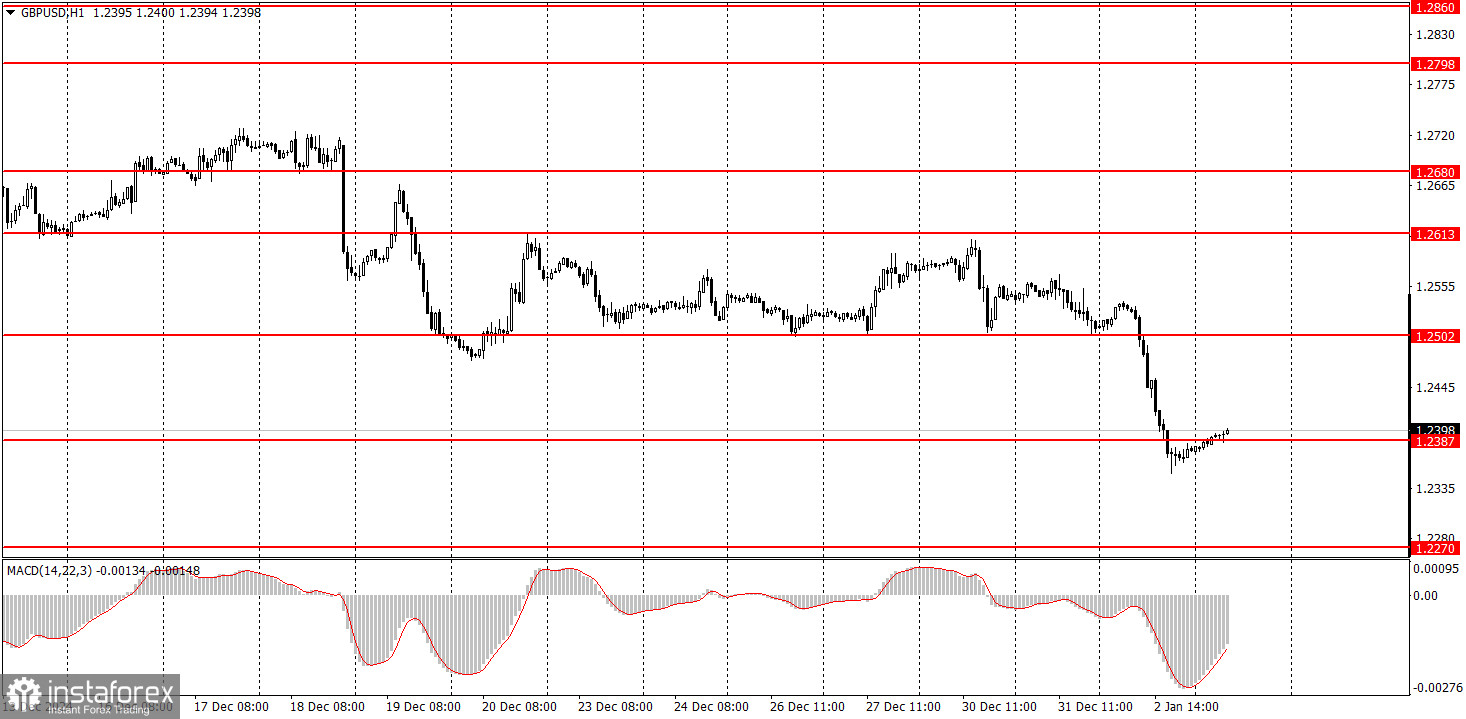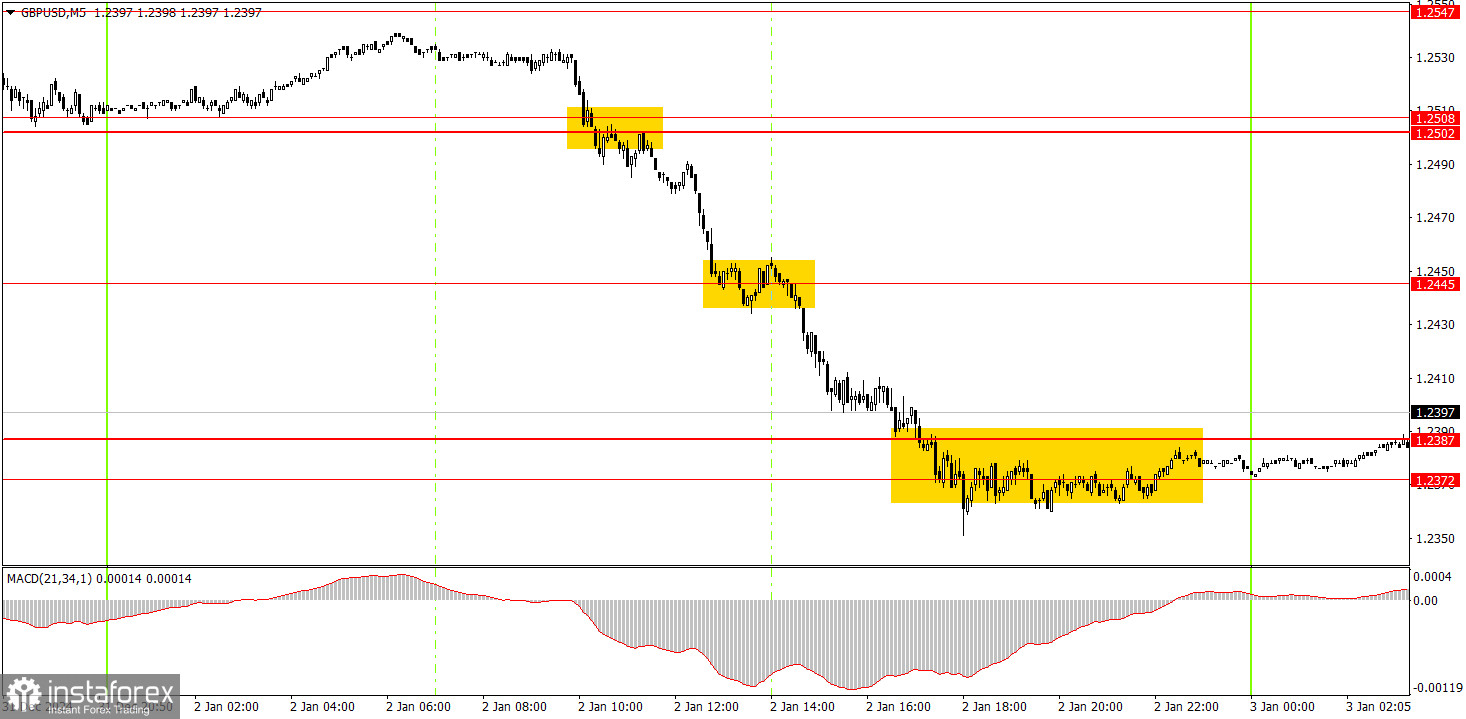Analysis of Thursday's Trades
1H Chart of GBP/USD

The GBP/USD pair experienced a sharp drop on Thursday. Similar to the euro, there were no local factors that could explain a nearly 200-pip decline, especially on the first trading day of the week. The fall on January 2nd was unexpected, but we had previously warned traders that the trend remained bearish, and any corrections or consolidations were likely being used by major players to build positions. Once these positions are established, we typically see trend movements, which is precisely what occurred yesterday. Therefore, in the medium term, the market's reaction was not surprising; it was simply a continuation of the downtrend that began months ago. The macroeconomic data released on Thursday had no relevance to this drop, as second estimates of business activity indices are not the kind of information that could theoretically trigger such a significant decline.
5M Chart of GBP/USD

On the 5-minute chart, Thursday provided several excellent trading signals, as the price moved consistently in one direction throughout the day without any retracements. Initially, the price broke through the 1.2502–1.2508 zone, followed by the 1.2445 level, and subsequently the 1.2372–1.2387 area. This trend allowed novice traders to easily open short positions on the first signal and close them below the 1.2372 level. The profit from this trade would have been at least 120–130 pips.
Trading Strategy for Friday:
On the hourly timeframe, GBP/USD has exited the New Year's consolidation phase and has resumed its main trend. In the medium term, we anticipate a decline in the pound, as this seems to be the most logical outcome. Therefore, we expect further downward movement, but, as always, trades should rely on technical signals. The outcomes of the meetings held by the Bank of England and the Federal Reserve support the continuation of this bearish trend.
On Friday, GBP/USD may see a correction after yesterday's drop. The price has already consolidated above the 1.2372–1.2387 zone, indicating that further growth is possible up to the 1.2445 level.
On the 5-minute chart, key trading levels for today include: 1.2387, 1.2445, 1.2502–1.2508, 1.2547, 1.2633, 1.2680–1.2685, 1.2723, 1.2791–1.2798, 1.2848–1.2860, 1.2913, and 1.2980–1.2993. On Friday, there are no significant events scheduled in the UK, but in the US, the important ISM Manufacturing Index will be released. This report could cause significant movement in the forex market, so be prepared for a sharp reversal or strong fluctuations at the start of the US trading session.
Core Trading System Rules:
- Signal Strength: The shorter the time it takes for a signal to form (a rebound or breakout), the stronger the signal.
- False Signals: If two or more trades near a level result in false signals, subsequent signals from that level should be ignored.
- Flat Markets: In flat conditions, pairs may generate many false signals or none at all. It's better to stop trading at the first signs of a flat market.
- Trading Hours: Open trades between the start of the European session and the middle of the US session, then manually close all trades.
- MACD Signals: On the hourly timeframe, trade MACD signals only during periods of good volatility and a clear trend confirmed by trendlines or trend channels.
- Close Levels: If two levels are too close (5–20 pips apart), treat them as a support or resistance zone.
- Stop Loss: Set a Stop Loss to breakeven after the price moves 20 pips in the desired direction.
Key Chart Elements:
Support and Resistance Levels: These are target levels for opening or closing positions and can also serve as points for placing Take Profit orders.
Red Lines: Channels or trendlines indicating the current trend and the preferred direction for trading.
MACD Indicator (14,22,3): A histogram and signal line used as a supplementary source of trading signals.
Important Events and Reports: Found in the economic calendar, these can heavily influence price movements. Exercise caution or exit the market during their release to avoid sharp reversals.
Forex trading beginners should remember that not every trade will be profitable. Developing a clear strategy and practicing proper money management are essential for long-term trading success.





















